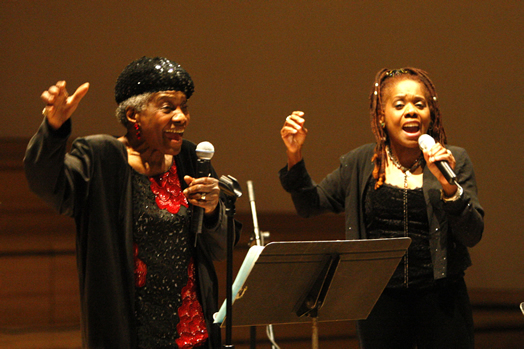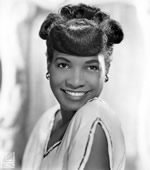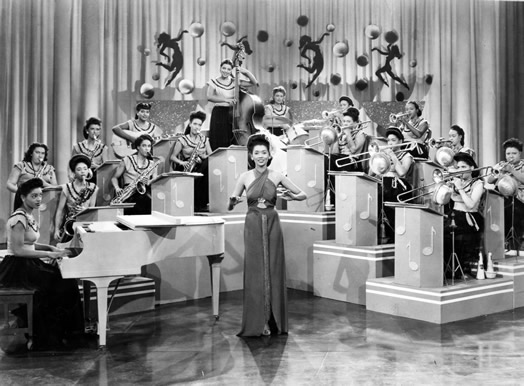Allegro
‘Be your own self’
A tribute to Carline Ray's musical life
Volume 113, No. 8September, 2013

Carline Ray and her daughter Catherine Russell in 2008. Photo: Joseph A. Rosen
The life of Carline Ray (1925-2013), the champion of bass, was as rich and deep as her luxuriant contralto voice. A professional singer and electric bass specialist for 54 years, Ray was an activist as well as a premier musician. She was a member of Local 802 since 1945, served on the union’s trial board for six years, and was an active member of the Jazz Advisory Committee. But she also stood up for fellow musicians even when there was no union agreement.
For instance, there was the time Ray and her lifelong friend and musical collaborator, Edna Smith, got a job playing in a ten-cents-a-dance hall. Ray (on piano) and Smith (on bass) were the only women in the band. “The band had to play continuously,” Ray remembers, so she figured out a way to get them some breaks. “The boss liked ‘Stardust,’ so I told him I would sing it for him if he would let everybody off for five minutes. I would do this just about every night. He just loved ‘Stardust’!”

Carline Ray’s first publicity shot. Photo: Carline Ray Collection
Born and raised in Harlem, Carline Ray grew up surrounded by music. Her father, Elisha Manasseh Ray, was a member of Local 802 and a graduate of Juilliard, who played the bass, tuba and euphonium. He taught Ray piano and rudimentary theory when she was young, and she always knew that she wanted to be a musician. In junior high she discovered her voice and started singing in glee clubs and choruses.
Ray entered Juilliard as a piano major, studying with Harold Lewis and Gordon Stanley, and later studied composition. She graduated with a composition degree in 1946, and 10 years later earned a master’s in voice from the Manhattan School of Music.
While still at Juilliard, she began exploring jazz after school hours. She and Edna Smith, a bass major, started playing in clubs and spending time on 52nd Street, where Ray heard musicians like Sarah Vaughan, Billie Holiday and Art Tatum. In those days she was doing more listening than playing, but she would often go up to a jam session in Harlem at a place called The Hollywood. There she met Billy Taylor, and heard Willie “The Lion” Smith, and other stride pianists. Tatum always played last. “Nobody followed Art Tatum; he was the king.”
Ray already had a reputation as a singer, and at The Hollywood one night she was asked to sing. Tatum offered to accompany her. “I was speechless, of course. So I sang a Gershwin tune. When I got through Art asked, ‘Well, Carline, did I play all right for you?’ “
It was around this time that she and Edna got a job playing weekends at Pete and Dom’s Restaurant in Staten Island, and Ray joined Local 802. “In those days you had to audition to get into the local. They asked for a little Bach, a little Beethoven, a little boogie-woogie, and I accommodated.” Also around this time, she began teaching herself guitar, and soon was playing on gigs.
In 1956, while she was playing in a band fronted by her late husband, the pianist-composer Luis Russell, Ray decided to give the bass a try. “I took to it like a fish to water.”
Ray started subbing for Smith on her gigs and became the regular bass player for her husband’s group, at a time when few musicians were playing the instrument. “A lot of people have accused me of causing them to play electric bass,” says Ray. “I may have inspired some people to think they could sound like me, but you have to know ahead of time what kind of sound you want. I was trying to emulate the sound of an upright bass; I always wanted that big sound.” One musician who influenced her strongly was Ray Brown. “He had this big, fat, round sound with ringing notes. It really moved me, and I said to myself that if I was ever going to be a bass player, that’s the way I’d want to sound. Ray Brown is my mentor, but he doesn’t know it. That sound continues to be my motivation.”
Her first big band experience came in 1946, when she and Edna Smith met Maurice King, the musical director for the all-female Sweethearts of Rhythm, and soon joined the group. Ray was the rhythm guitarist and special production vocalist, and when she sang “Temptation” at the Million Dollar Theater in Los Angeles, she brought down the house. “I was overwhelmed,” she said.
Ray had never been west of New Jersey before, but she happily traveled around the country in a bus fitted out with sleeper berths that was home to the 16 women in the Sweethearts of Rhythm. In those days, she recalls, “Jim Crow was alive and kicking and flying around and carrying on – so there was always the specter of that hanging over us, whenever we went down South.” Ray and the Sweethearts did a “Black Circuit,” covering the Apollo in New York and the Howard in Washington, D.C., among other venues.

Carline Ray played with the International Sweethearts of Rhythm; she’s pictured on guitar (second row, third from the left). Photo: Carline Ray Collection
Next, Ray was invited to sing with a band led by trumpeter Erskine Hawkins, based at the Savoy Ballroom. She was the only woman in the band but she felt respected. “A few guys tried to hit on me, but I had a couple of ‘big brothers’ who would look out for me,” she said. “I was never intimidated by my male counterparts.”
Ray didn’t see herself as a pioneer among female musicians because, she said, so many women came before her. But she pointed out that “it’s only now that women musicians are starting to be taken seriously.” When she was starting out, she said, agents “didn’t care about your talent. They always approached a woman based on the way she looked. But I view myself and any other woman musician as a musician first, who just happens to be female.”
She recalled that it was a long time before she saw any woman musicians in the New York Philharmonic. Ray believed that women in music now have more respect and acceptance, but she noted that this has happened “very slowly and grudgingly, as far as classical orchestras are concerned” – and that some female musicians “still seem to be intimidated.”
She also recalled problems with sexism in the union. “I received a lot of mail over the years addressed to ‘Dear Brother.’ Even the union hasn’t always recognized women.”
The union has not always supported jazz artists as strongly as Ray would have liked, but she was optimistic about Local 802’s Justice for Jazz Artists campaign and became deeply involved with the Jazz Advisory Committee. “I was very impressed with the composition of the committee – the fact that people like Jamil Nasser and Benny Powell were involved – and I could see that Local 802 was serious about this.”
Ray did it all. She taught at Medgar Evers College. She met Miles Davis on the A train, where they chatted about Sarah Vaughan. She played with numerous top musicians, including Mary Lou Williams, Mercer Ellington and Skitch Henderson. She received an NEA grant to study acoustic bass with Major Holley. She helped form Jazzberry Jam, made up of herself, Bertha Hope on piano, Paula Hampton on drums and the late Gwen Cleveland on vocals. And she raised a daughter, Catherine Russell, the well-known and highly respected vocalist.
What advice would she give musicians?
“As a jazz musician, you have to decide where in this wide spectrum of music you want to be represented. You have to aspire to be as individual as you can be; it has to be you injected into this music. You just can’t be a copycat, playing something just because someone else is playing it. Every one of us has individual aspects of our performance – something that is special about them. Be your own self.”
Mikael Elsila is the editor of Allegro. This story was edited from an interview that first appeared in Allegro in 1998.
